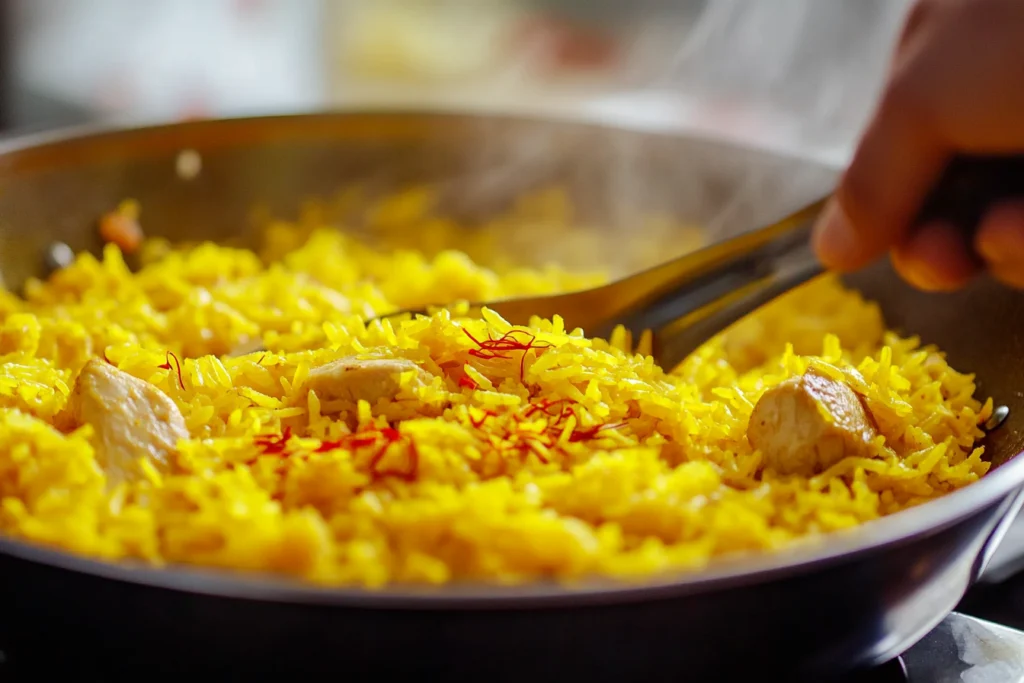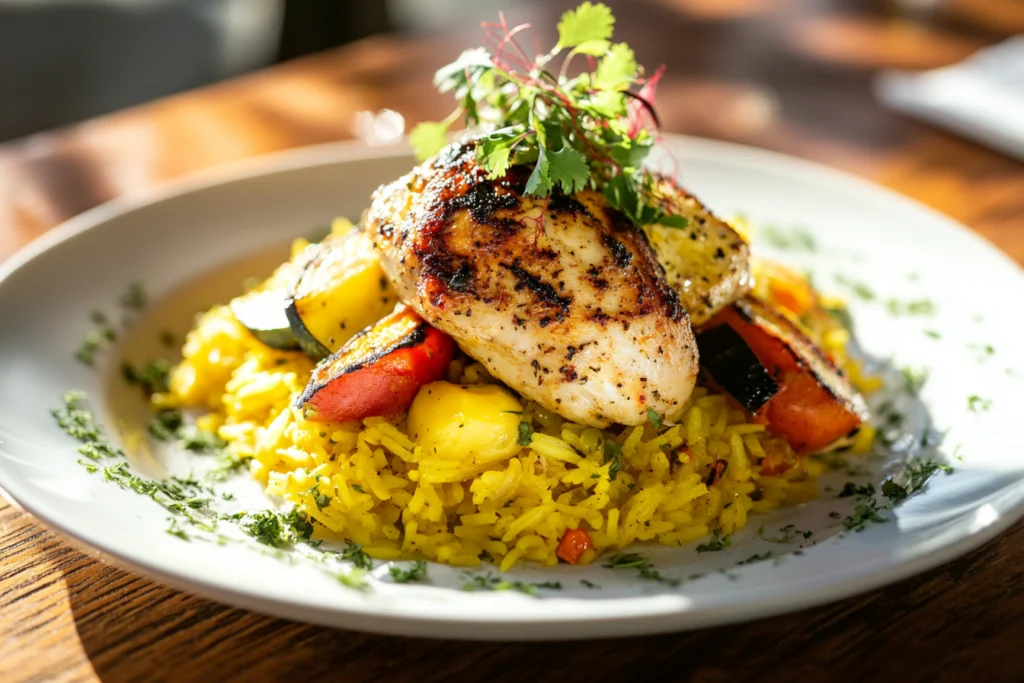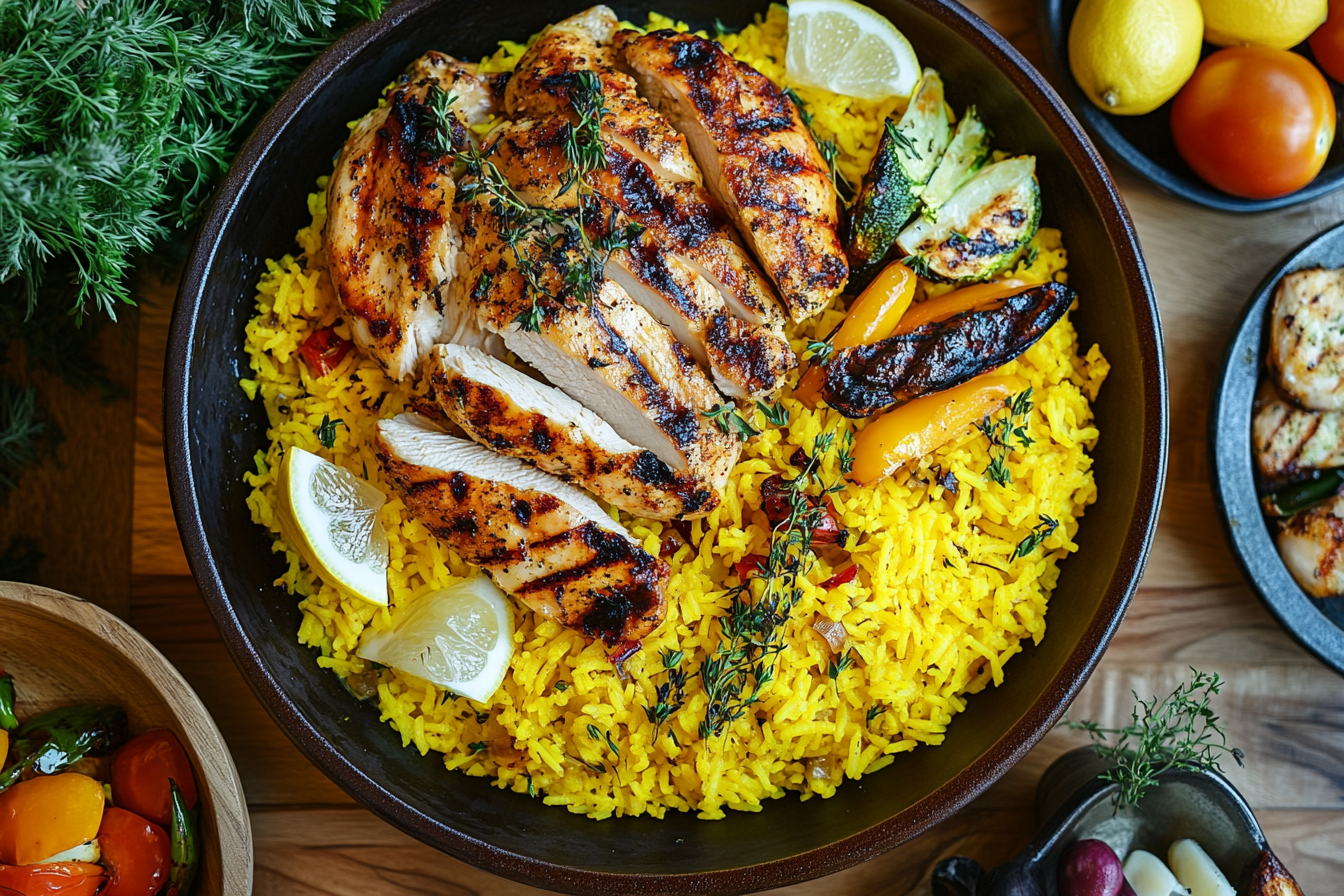Yellow rice and chicken is a widely enjoyed dish, beloved for its comforting flavors and versatility. But is this popular meal healthy? This article dives into the nutritional benefits, potential downsides, and practical tips for making yellow rice and chicken a healthier option. From its preparation methods to comparisons with other meals, we’ll explore every aspect to help you make informed dietary choices.
Introduction
What is Yellow Rice and Chicken?
Yellow rice and chicken is a classic dish combining fluffy, golden-hued rice with tender, flavorful chicken. The rice owes its bright color to spices like turmeric or saffron, while the chicken is often marinated or seasoned for extra taste. This dish is enjoyed in cuisines worldwide, with variations influenced by cultural traditions.
Importance of Analyzing Its Health Benefits
Given its widespread appeal, it’s natural to wonder about the health implications of regularly eating yellow rice and chicken. Does it provide essential nutrients, or does it carry hidden health concerns? By understanding its nutritional profile, you can decide how it fits into your overall diet and even discover ways to enhance its benefits.
Nutritional Profile of Yellow Rice and Chicken
Yellow Rice: Ingredients and Nutrients
Yellow rice derives its vibrant hue and distinct flavor from spices like turmeric or saffron. These spices not only add color but also pack significant nutritional benefits. Turmeric, for instance, contains curcumin, known for its anti-inflammatory and antioxidant properties. Other common ingredients like broth, onions, and garlic further enhance its nutrient density.
Typically, yellow rice is made from white or brown rice. While white rice is a good source of quick energy, brown rice offers added fiber and micronutrients, making it a better choice for those seeking sustained energy and better digestion.
Nutritional Content (Per 100g of Cooked Yellow Rice)
| Nutrient | Amount |
|---|---|
| Calories | 112 kcal |
| Carbohydrates | 23.5 g |
| Protein | 2.4 g |
| Fat | 0.3 g |
| Fiber | 1.0 g |
Chicken: Nutritional Breakdown
Chicken is a lean protein powerhouse, making it a staple in many healthy diets. Rich in essential amino acids, it supports muscle repair and growth. Skinless chicken breast, in particular, is low in fat and an excellent source of vitamins B6 and B12, niacin, and selenium—all essential for maintaining energy levels and boosting immunity.
Whether grilled, baked, or roasted, chicken retains most of its nutrients with minimal fat when prepared using healthier cooking techniques.
Nutritional Content (Per 100g of Cooked Skinless Chicken Breast)
| Nutrient | Amount |
|---|---|
| Calories | 165 kcal |
| Protein | 31 g |
| Fat | 3.6 g |
| Cholesterol | 85 mg |
| Sodium | 74 mg |
By combining yellow rice and chicken, the dish becomes a balanced source of carbohydrates for energy, proteins for muscle repair, and a moderate amount of fats for satiety.

Health Benefits of Yellow Rice and Chicken
High Protein Content
One of the standout benefits of this dish is its impressive protein content, thanks to the chicken. Protein is vital for repairing tissues, building muscle, and maintaining a strong immune system. For those leading an active lifestyle, a meal featuring yellow rice and chicken can be a great post-workout option to replenish and rebuild muscles.
Essential Vitamins and Minerals
Yellow rice, enriched with spices like turmeric and cooked in nutrient-dense broths, provides a wealth of vitamins and minerals. Chicken adds to this by offering selenium, which promotes thyroid health, and niacin, known to support brain function and reduce inflammation. Combined, these ingredients help maintain energy levels and overall health.
Additionally, turmeric’s curcumin is celebrated for its anti-inflammatory properties, which can contribute to improved joint health and reduced risk of chronic diseases. It’s like getting a health boost with every bite!
Role in Muscle Building and Recovery
The balanced combination of carbohydrates from yellow rice and lean protein from chicken makes this dish ideal for muscle building and recovery. Carbohydrates help replenish glycogen stores in the body, while protein supports muscle repair and growth. This balance ensures that the dish can fuel both athletic performance and daily activities.
Potential Downsides
High Sodium Content in Yellow Rice
Yellow rice, especially when prepackaged or restaurant-made, can be high in sodium due to added salts, bouillon, or broth concentrates. High sodium intake may lead to health concerns like high blood pressure and fluid retention. To make it healthier, opt for low-sodium broths and reduce the added salt during cooking.
Overuse of Unhealthy Oils or Fats
The cooking process can also influence the healthiness of the dish. Using excessive butter or oil to prepare yellow rice can significantly increase its calorie count. Similarly, frying chicken rather than baking or grilling can add unhealthy fats. Choosing healthier preparation methods is key to keeping this dish nutritious.
Risks of Overeating
While yellow rice and chicken is a balanced meal, its delicious taste can make it easy to overconsume. Portion control is crucial to avoid excess calorie intake, especially if the dish is paired with calorie-dense sides like fried plantains or creamy sauces.

Is It Suitable for Specific Diets?
Keto and Low-Carb Diets
Unfortunately, yellow rice, made from white or brown rice, is high in carbohydrates and may not align with keto or strict low-carb diets. However, substituting regular rice with cauliflower rice or other low-carb alternatives can transform the dish into a keto-friendly option. The chicken, being high in protein and low in carbs, fits perfectly within these diets.
Gluten-Free Options
For those following a gluten-free diet, yellow rice and chicken can be an excellent choice if prepared with gluten-free ingredients. Always double-check the seasonings, broths, or spice blends used in the recipe to ensure they don’t contain hidden sources of gluten.
Low-Calorie Diets
Yellow rice and chicken can fit into a low-calorie diet if you manage portions and use healthier preparation methods. Opting for whole-grain rice over white rice, reducing added fats, and steaming or grilling the chicken can significantly cut calories while maintaining flavor.
Preparation Methods and Their Impact on Health
Traditional Cooking Methods
In traditional recipes, yellow rice is often simmered with chicken broth, saffron, or turmeric, and seasoned with a mix of spices. While this method retains the dish’s authentic flavor, it can sometimes involve high amounts of salt and oil, impacting its overall healthiness.
Healthier Cooking Alternatives
To make yellow rice and chicken healthier:
- Rice Preparation: Use brown rice or quinoa as a base instead of white rice. These options are richer in fiber and provide better glycemic control.
- Chicken Cooking Methods: Opt for grilling, baking, or air-frying chicken instead of frying it. These techniques preserve the chicken’s natural flavors while keeping the calorie count low.
- Broth Choices: Use low-sodium or homemade chicken broth to reduce the sodium content.
The Impact of Seasonings and Additives
While spices like turmeric and saffron offer health benefits, store-bought mixes may include added sugars, preservatives, or sodium. Making your own seasoning mix at home allows better control over the ingredients, ensuring the dish remains as nutritious as possible.
Comparing Yellow Rice and Chicken to Other Meals
Comparisons with Other Rice Dishes
Yellow rice and chicken stands out among rice-based meals due to its vibrant color and unique spice profile. Compared to dishes like plain white rice with grilled chicken, the addition of turmeric or saffron boosts the dish’s antioxidant levels. However, compared to brown rice dishes, it may lack the additional fiber that aids digestion and promotes satiety.
When compared to fried rice or biryani, yellow rice and chicken is typically lower in oil and calories when prepared healthily. Its simplicity makes it an appealing choice for those looking to enjoy a balanced, less calorie-dense meal.
Comparing to Vegetarian Options
Vegetarian meals like lentil-based curries or quinoa bowls may offer comparable protein levels with added fiber and plant-based antioxidants. While yellow rice and chicken excels in lean protein content, vegetarian alternatives often come with fewer fats and cholesterol. Incorporating more vegetables into yellow rice and chicken can help bridge this gap and increase its fiber and vitamin content.
Tips for Making Yellow Rice and Chicken Healthier
Reducing Oil and Sodium
Using a non-stick pan or an air fryer can drastically reduce the oil needed for cooking. Additionally, opting for low-sodium broths or skipping added salt altogether can make the dish heart-healthier without compromising too much on flavor.
Using Whole-Grain or Alternative Rice
Substitute white rice with whole-grain options like brown rice or wild rice. If you’re watching your carbohydrate intake, consider using cauliflower rice or quinoa, which are nutrient-dense and lower in carbs.
Adding More Vegetables
Bulk up your yellow rice with nutrient-rich vegetables like bell peppers, carrots, peas, or spinach. These additions not only enhance the dish’s flavor but also provide more vitamins, minerals, and fiber, making it more filling and balanced.
FAQs
Is yellow rice and chicken good for weight loss?
Yes, yellow rice and chicken can be good for weight loss when prepared with healthier ingredients and proper portion control. Using brown rice instead of white rice, opting for grilled or baked chicken, and reducing added fats and sodium can make this dish a low-calorie and nutrient-dense option.
Can diabetics eat yellow rice and chicken?
Diabetics can enjoy yellow rice and chicken by moderating portion sizes and using whole-grain alternatives like brown rice or quinoa. These substitutes have a lower glycemic index than white rice, helping to maintain steady blood sugar levels. Also, opting for lean chicken without added sugar or high-sodium marinades is essential.
How often can I eat yellow rice and chicken?
Yellow rice and chicken can be part of a healthy diet if consumed in moderation. Eating it a few times a week is fine, especially when balanced with vegetables and healthy fats. Avoid making it your sole meal option by rotating it with other protein and carbohydrate sources for variety and nutritional balance.
What are the healthiest ways to cook yellow rice and chicken?
The healthiest ways to cook yellow rice and chicken include steaming or boiling the rice with minimal salt and baking or grilling the chicken with a light marinade. Adding plenty of vegetables and using spices instead of heavy sauces further enhances the dish’s nutritional profile.
Does yellow rice have more benefits than plain rice?
Yellow rice often has more health benefits than plain rice due to the addition of spices like turmeric or saffron. These spices provide antioxidants and anti-inflammatory properties, making yellow rice a slightly healthier option. However, the base (white or brown rice) still determines its core nutritional value.
Is yellow rice and chicken suitable for kids?
Absolutely! Yellow rice and chicken is a nutritious, kid-friendly dish that can be easily customized to their taste preferences. Reducing the spice level and including colorful vegetables make it more appealing and beneficial for growing children.
Conclusion
Summarizing Key Takeaways
Yellow rice and chicken is a versatile dish that can be both delicious and nutritious when prepared thoughtfully. Its combination of protein-rich chicken and carbohydrate-dense rice makes it a balanced meal, providing energy, essential nutrients, and satisfying flavors. By using healthier ingredients and cooking methods, this dish can easily fit into various dietary needs and preferences.
Final Thoughts on Its Health Impact
Whether you’re aiming for a post-workout recovery meal, a family-friendly dinner, or a balanced diet option, yellow rice and chicken ticks many boxes. It’s versatile, easy to prepare, and can be tailored to meet specific health goals. With a few tweaks, this dish can go from comfort food to a powerhouse of nutrition, proving that health and flavor can go hand in hand.


1 thought on “Is Yellow Rice and Chicken Healthy? A Complete Nutritional Guide”